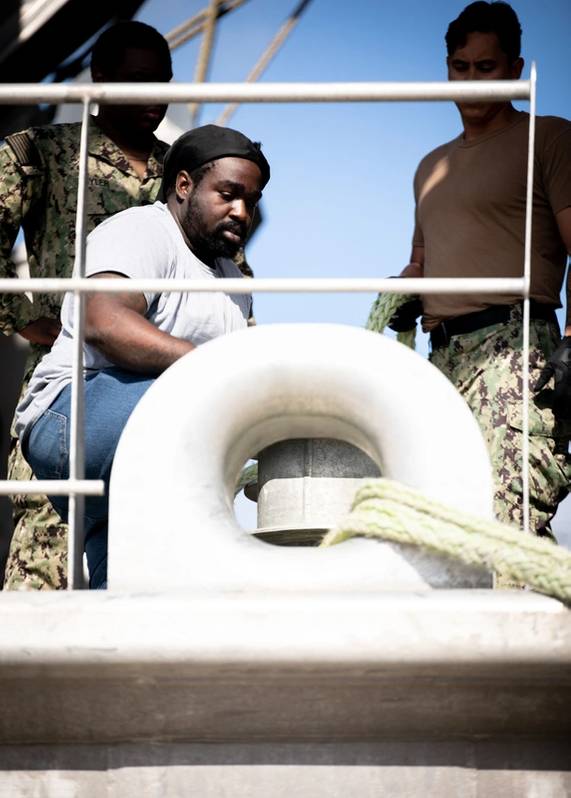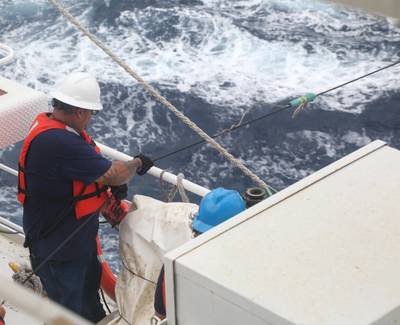Help Wanted: US Maritime Industry Struggles to Fill Key Gaps
A shortage of U.S. mariners presents a major threat to the United States’ national and economic security, and the problem is growing day by day.
According to a 2017 study prepared by the Maritime Workforce Working Group and released by the U.S. Maritime Administration (MARAD), the estimated pool of U.S. mariners actively sailing with unlimited tonnage credentials was comprised of 11,768 mariners. Assuming that all these mariners would be both willing and available to sail as needed, this number falls 1,839 qualified mariners short of the 13,607 needed to sustain a full activation of the Ready Reserve Force (RRF) and the nation’s commercially operated vessels to meet sealift needs, the study found.
The issue is particularly worrisome given the current state of world affairs, as conflicts rage and geopolitical tensions simmer across the globe. In the time since the study was published, the U.S. mariner workforce situation has not improved; in fact, it has only gotten worse.
“Globally standardized credentialing requirements have had an impact on the U.S. Merchant Marine. And of course, the maritime industry—like many other industries—has also been profoundly affected by the COVID-19 pandemic,” Rear Admiral Ann C. Phillips, Maritime Administrator, said during a House committee hearing in May 2023. “Both of these developments have negatively impacted mariner retention.”
In a recent interview for Maritime Reporter & Engineering News, Rear Adm. Philip Sobeck, Commander of U.S. Military Sealift Command (MSC), addressed an across-the-board shortage of civil service mariners (CIVMAR) to man MSC ships.
“Our shortfall is in the middle to senior positions within our licensed mariners, but we need to attract the junior people now, those third-class mariners with the certifications they get from school, and start building our workforce from within,” Sobeck said. “We need to both recruit and retain today, in order to have the force we need tomorrow.”
 File photo: U.S. Navy sailors and civil service mariners (CIVMAR) assigned to USNS Burlington (T-EPF 10) moor the ship to the pier at Joint Expeditionary Base Little Creek-Fort Story (Credit: Ryan Carter / U.S. Navy)
File photo: U.S. Navy sailors and civil service mariners (CIVMAR) assigned to USNS Burlington (T-EPF 10) moor the ship to the pier at Joint Expeditionary Base Little Creek-Fort Story (Credit: Ryan Carter / U.S. Navy)
“COVID created a lot of uncertainty, and kept us from actively recruiting, and it made everything more difficult because we were constrained from the normal personnel rotations. We are competing with the commercial shipping companies, as well as other jobs that value the skills that our mariners have. We’re not alone in this fight for talent, the entire shipping industry is experiencing a shortage. MSC competes well with the rest of the U.S. maritime industry when it comes to pay and benefits, but there can be issues regarding rotations and time off.
“With COVID, we had to make some hard choices for our mariners because we couldn't rotate. Many of our mariners found other employment, and were able to use their skills and their tradecraft in other ways. That had an impact on our workforce. We thought we would have rebounded by now, but many of our mariners have not come back.
“We are in that tough period with both recruiting and retention at the same time. It’s a national problem.
“We need to ensure our pay and benefits; the predictability of our rotations; and the time off compares favorably with the commercial maritime industry.”
MARAD’s Ready Reserve Force contains a number of ships that can be manned up for MSC to deploy to support sealift operations in a time of crisis. If all ships were to be activated, there are enough mariners to man them, but only for a limited time, Sobeck said. “The problem is sustaining that. We don’t have the reliefs.”
“That’s my concern if we get into a large-scale, long-term operation. We can be reasonably certain that we won’t have all of our ships going at one time. There will be some sort of prioritization, and we’ll be able to manage that mobilization to some point, but we’re concerned with how we would sustain those ships at sea, and provide for some kind of relief for our people.”
So how can the problem—the shortage of qualified U.S. mariners—be solved? That’s exactly what lawmakers and agencies such as MARAD and the U.S. Coast Guard, among many others—including commercial maritime industry partners—are trying to figure out.
MARAD has been working to find new ways to bolster the nation’s maritime workforce, leading a number of initiatives to support mariner training and education. These include providing new training ships for state maritime academies, designating Centers of Excellence for Domestic Maritime Workforce Training and Education, cracking down on sexual assault and misconduct among cadets and seafarers, among others. Importantly, it has also led efforts to grow the U.S.-flag fleet, creating more job opportunities for American mariners.
In an effort to strengthen the CIVMAR program and improve MSC’s ability to retain and grow its workforce, Sobeck said MSC is also implementing various initiatives, including the creation of MyMSC, a web-based career portal for CIVMARs.
“We want our people to be able to track their rotations, and the accrual of leave, management of travel pay, and make available the assignments that are best suited for our people,” Sobeck said. “We can track all of the certifications; Coast Guard licensing; and skill sets across the entire force. A master with an all-tonnage license can pretty much sail on any of our ships and can be detailed world-wide, although some ships like EPF require high-speed craft (HSC) training. So, MyMSC will help track and manage all of those different things in one place. We’re hoping that makes things easier for our people, and that it will help us to retain them. Unfortunately, we can’t guarantee everyone their choice of ship assignment because we just don’t have the mariners.”
 Rear Adm. Philip Sobek, commander, Military Sealift Command (MSC), delivers remarks aboard USS Dwight D. Eisenhower (CVN 69) during MSC’s change of command ceremony held on board the ship, September 8, 2023. (Credit: Ryan Carter / U.S. Navy)
Rear Adm. Philip Sobek, commander, Military Sealift Command (MSC), delivers remarks aboard USS Dwight D. Eisenhower (CVN 69) during MSC’s change of command ceremony held on board the ship, September 8, 2023. (Credit: Ryan Carter / U.S. Navy)
MSC is not alone in its constant hunt for personnel. The U.S.’ National Oceanic and Atmospheric Administration (NOAA), currently in the midst of expanding its fleet, is always seeking mariners to join its ranks, Chris Nichols, a professional mariner recruiter for the agency, told Maritime Reporter TV in late 2023.
“NOAA has 15 scientific research vessels, and we have two more being built down in Louisiana at this time,” Nichols said. “We're hiring positions for the deck department, supply department, and we're specifically really, really looking for marine engineers. There's even a $10,000 signing bonus.”
“There's a shortage of mariners in the world right now, and NOAA’s really focusing on finding the best ones that we can,” Nichols said. “The workforce for this continues to ebb and flow, but right now we're specifically looking for ABs [able seamen], marine engineers and folks with significant fishing experience.”
Looking across the entire maritime industry, shoreside workforce shortages are having major impacts, too. Both the Navy and Coast Guard, as well as a number of commercial maritime and offshore industry stakeholders, have cited worker shortages at shipbuilding and repair facilities as having a negative impact on their operations. Coast Guard officials, for example, have pointed to a shortage of qualified shipyard workers and engineers as a major cause for delays across its shipbuilding and acquisitions programs. The story is the same for the U.S. Navy, which has five classes of ships that have fallen years behind schedule, prompting Navy Secretary Carlos Del Toro earlier this year to order a comprehensive review to examine national and local causes of shipbuilding challenges.
“You’d be hard pressed to find a shipyard that doesn't wish it had more skilled laborers—welders, machinists, pipe fitters, electricians, etc.,” said Joey Laplant, a recruitment consultant at DSJ Global. “They're all fishing from the same small pool of candidates.”
 File photo: A shipyard worker grinds on the deck of a future Coast Guard Cutter (Credit: Jeff Hall / U.S. Coast Guard)
File photo: A shipyard worker grinds on the deck of a future Coast Guard Cutter (Credit: Jeff Hall / U.S. Coast Guard)
Laplant, who works with many U.S. shipbuilding companies and candidates as part of DSJ Global’s engineering team, said the maritime industry has a “branding problem”. Much of the industry’s workforce is aging, and fresh faces have been slow to fill the void left by an uptick in retirements. A big part of the problem, he said, is that many outside of the industry are often unaware that it even exists.
“Visibility is a really big challenge. We do not have enough people moving into the maritime space either from another industry or just fresh out of college, deciding what they want their future to look like,” Laplant said. “I'll speak with candidates who have recently entered the workforce; they’re pretty fresh out of college and looking to go into some kind of heavy manufacturing industry. Very rarely will I have someone mention an interest in the shipbuilding industry without my own prompting.”
In shipbuilding, the pay is generally lower and working conditions often harsher than those found in other industries such as aerospace, automotive and defense, Laplant added. “I think that if shipbuilding's going to be competitive, there's definitely going to need to be campaigns to increase visibility in the industry, a rise in wages and hopefully some kind of improvement on creature comforts like you can get in rival industries,” he said.
These issues extend beyond the skilled trades, Laplant said he is seeing a significant shortage of qualified and experienced people for management roles as well.
“In the next few years, I anticipate the most in demand white collar job titles in the shipbuilding and repair industry are going to be project engineers, project managers and estimators. Right now, I'm starting to see a ramp up in need, and I'm already anticipating the lack of talent in those specific titles. In the next three years, those are going to be really hot positions.”














